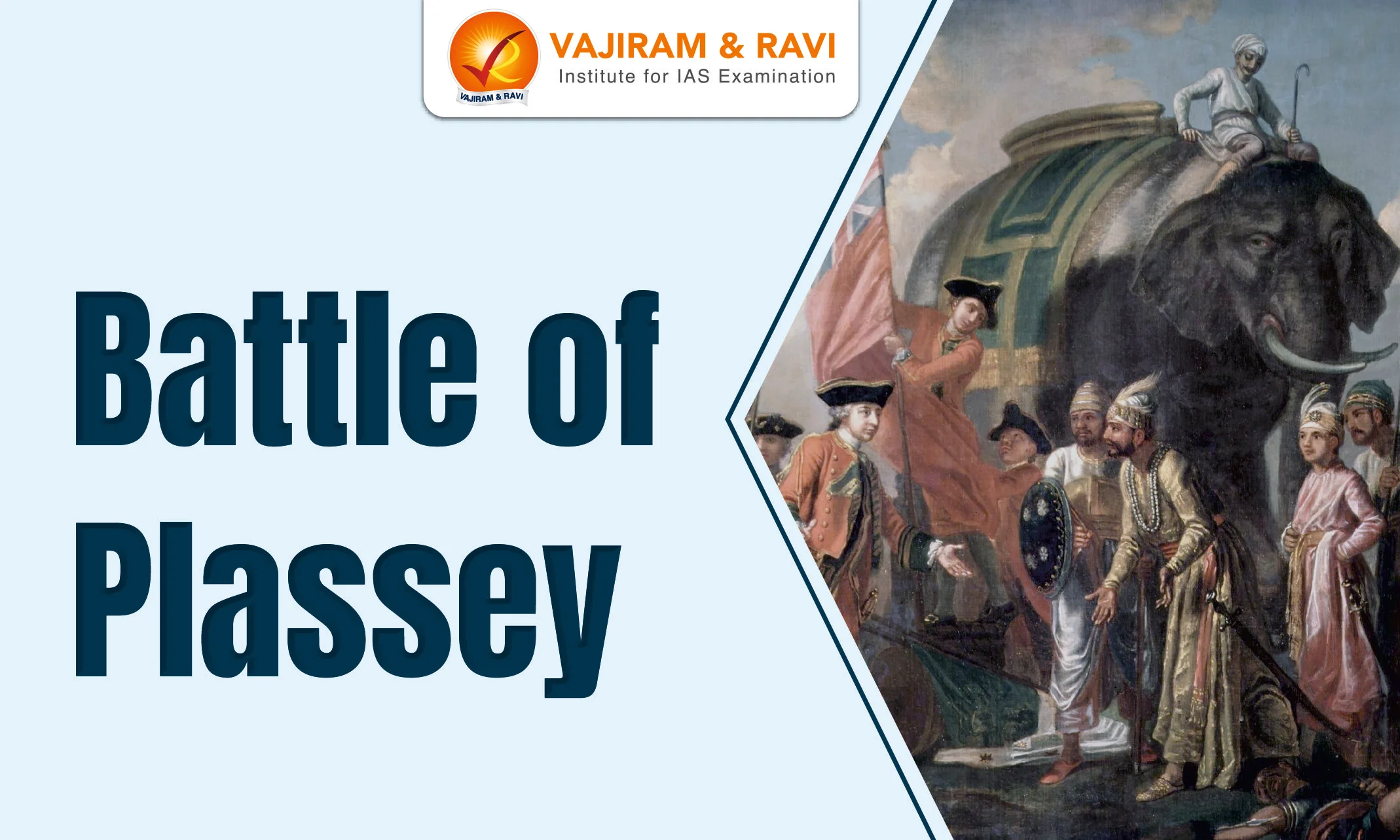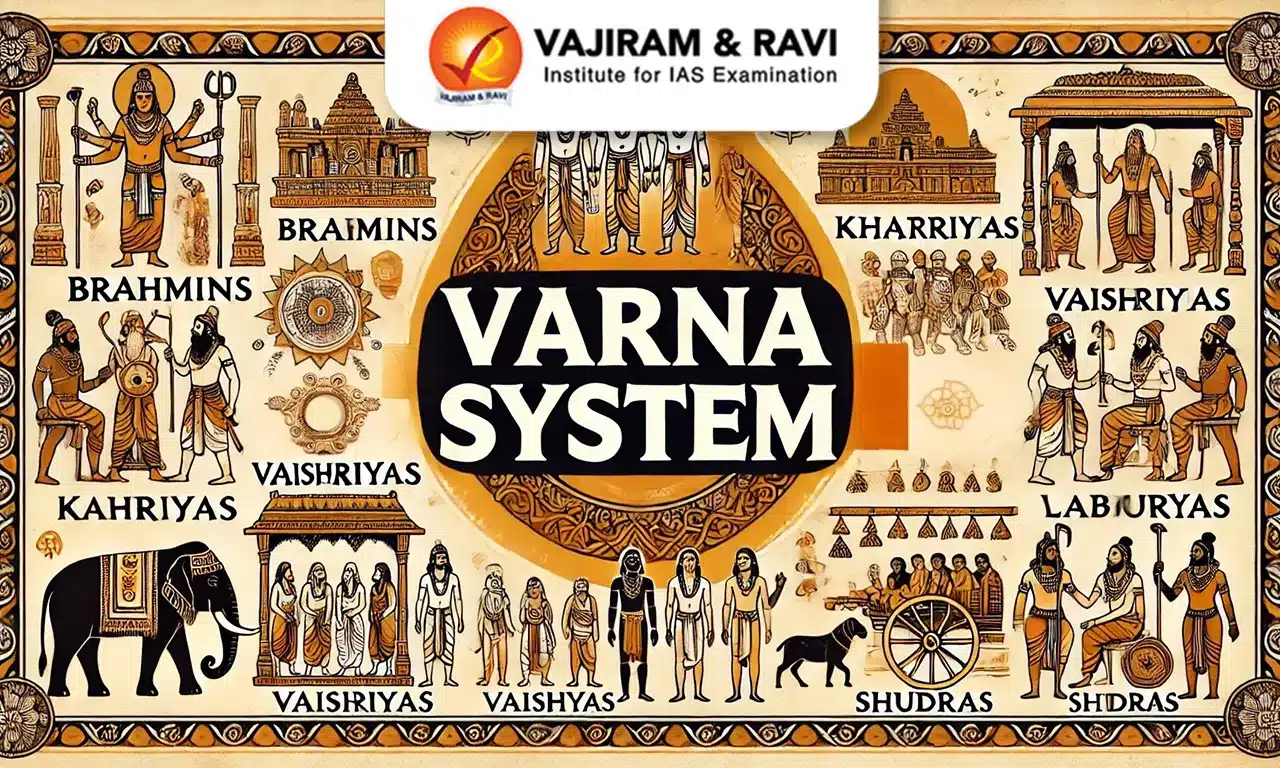The Battle of Plassey, fought on June 23, 1757, near the village of Plassey in Bengal, saw the British East India Company clash with the forces of Siraj-ud-daulah, the Nawab of Bengal, amid growing tensions over British privileges and the Nawab’s resistance. The conflict was further fueled by political intrigues and internal rivalries within Siraj-ud-daulah’s camp. By strategically leveraging alliances and capitalizing on the betrayal of key figures, the British emerged victorious.
This decisive victory allowed the East India Company to expand its influence over Bengal, paving the way for British dominance in India. The outcome significantly reshaped the region’s political and economic landscape, marking the beginning of British colonial rule in the subcontinent.
Bengal on Eve of Battle of Plassey
Between 1757 and 1765, power gradually shifted from the Nawabs of Bengal to the British, as the latter defeated the former.
- Conflict of interests: The conflict between English commercial interests and the Bengal government, which resented the privileges of the East India Company, led to tensions between them.
- Commercial interest: The English East India Company had significant commercial interests in Bengal, as nearly 60% of British imports from Asia comprised goods from Bengal.
- Factories: The Company had established factories in Balasore, Hooghly, Kasimbazar, Patna, and Dacca during the 1630s, and the foundation of Calcutta in the 1690s completed the process of English commercial settlement in Bengal.
- Nawabs of Bengal: Under the rule of Murshid Quli Khan (1700-1727), Shujauddin (1727-1739), and Alivardi Khan (1739-1756), Bengal experienced unprecedented progress.
- Undisturbed Region: The region remained relatively peaceful compared to the rest of India, which faced inter-border disputes, Maratha invasions, Jat revolts, and external invasions by Nadir Shah and Ahmed Shah Abdali.
- Cities like Calcutta, Dacca, and Murshidabad saw significant population growth during this period.
- Problem of EIC: However, the English East India Company’s privileged position and the loss it caused to the provincial exchequer generated resentment among the governors of Bengal.
- This friction between the Company’s interests and the Bengal government became the leading cause of conflict.
Alivardi Khan and British
In 1741, Alivardi Khan, the Deputy Governor of Bihar, defeated and killed the Nawab of Bengal, Sarfaraz Khan, in battle. He secured his position as the new Subahdar of Bengal by paying a large sum of money to the Mughal Emperor, Muhammad Shah.
- Rule of Alivardi Khan: He ruled for 15 years and successfully repelled the Marathas.
- Company Fortifying its Settlements: Taking advantage of the Maratha incursions in Bengal, the English East India Company obtained permission from the Nawab to dig a ditch and construct an entrenchment around their settlement of Fort William.
- Alivardi Khan’s Concern: Later, Alivardi Khan became concerned about the growing power of European companies in the Carnatic region.
- Realizing this, he was urged to expel the Europeans from Bengal.
- However, Alivardi Khan passed away in 1756 before any action could be taken.
- He was succeeded by his grandson, Siraj-ud-daula, the son of Alivardi’s youngest daughter.
Siraj-ud-daula and British
Siraj inherited numerous troubles from his grandfather. He had a rival in his cousin, the Nawab of Purnea, Shaukat Jang.
- Challenges: He faced challenges from his hostile aunt, Ghasiti Begum, as well as a rebellious commander of the army, Mir Jafar, who was married to Alivardi Khan’s sister.
- There was a dominant group in his court comprising Jagat Seth, Omichand, Rai Ballabh, Rai Durlabh, and others who were opposed to him.
- In addition to these internal rivals, Siraj also faced a threat to his position from the growing commercial activities of the English East India Company.
- Actions in Haste: Impulsive by nature and lacking experience, Siraj felt insecure, which led him to make decisions that proved to be counterproductive.
- He defeated and killed Shaukat Jang in a battle, seized Ghasiti Begum’s treasures, and dismissed Mir Jafar, replacing him with Mir Madan.
- A Kashmiri officer named Mohan Lal was appointed to oversee the administration, and he acted as almost a Prime Minister.
Battle of Plassey Overview
The Battle of Plassey, fought on June 23, 1757, was a crucial conflict between the British East India Company and the forces of Siraj-ud-daulah, the Nawab of Bengal. The British, under Robert Clive, secured victory through strategic alliances with key figures in the Nawab’s camp, particularly Mir Jafar. This victory not only solidified British control over Bengal but also marked the beginning of British dominance in India, shifting power dynamics in the region.
Background of Battle of Plassey
The officials of the British East India Company made rampant misuse of their trade privileges, which adversely affected the finances of the Nawab. Moreover, the English fortified Calcutta without Nawab’s permission.
- Asylum to Fugitives: The Company further attempted to deceive him and exacerbated the situation by granting asylum to a political fugitive, Krishna Das, son of Raj Ballabh, who had fled with immense treasures against Nawab’s wishes.
- French Factor: The Company, in turn, suspected that Siraj ud-Daulah would collaborate with the French in Bengal to significantly reduce their trade privileges.
- This suspicion eventually led to an open display of hostility when Siraj attacked and seized the English fort at Calcutta.
- Immediate Cause-Black Hole Tragedy: According to popular belief, Siraj-ud-daulah imprisoned 146 English individuals in a very small room, resulting in the death of 123 of them due to suffocation.
Course of Battle of Plassey
The course of the Battle of Plassey was marked by strategic maneuvering and political intrigue that tilted the scales in favor of the British. Robert Clive’s leadership, combined with secret alliances, played a pivotal role in securing a decisive victory for the East India Company
- Arrival of Clive: The arrival of a strong force under the command of Robert Clive at Calcutta from Madras significantly strengthened the English position in Bengal.
- Secret alliances: Clive entered into a secret alliance with the traitors of the Nawab, including Mir Jafar, Rai Durlabh, Jagat Seth (an influential banker of Bengal), and Omichand.
- Deal: According to the deal, Mir Jafar would be made the Nawab, and in return, he would reward the English East India Company for their services.
- This secret alliance further solidified the English position, and thus, the outcome of the Battle of Plassey (June 23, 1757) was decided before the battle began.
- Defeat of Siraj: Due to the conspiracy involving Nawab’s officials, the 50,000-strong force of Siraj ud-Daulah was defeated by a small contingent of Clive’s forces. Siraj was captured and subsequently murdered under the orders of Mir Jafar’s son, Miran.
- Result: The Battle of Plassey granted the English access to the vast resources of Bengal.
- Monopolization of Trade: Following Plassey, the English virtually monopolized the trade and commerce of Bengal.
- Establishment of British Dominance: The battle solidified the British influence in India, establishing their dominance in Bengal and paving the way for further expansion of their colonial rule.
- Political Upheaval and Shift: The battle caused significant political upheaval in the region, leading to a shift in power dynamics and weakening the indigenous rulers.
Outcome of Battle of Plassey
The outcome of the Battle of Plassey led to significant political shifts and power struggles in Bengal. Mir Jafar, the new Nawab, grew increasingly frustrated with the British interference, which eventually led to his downfall.
- Defeat of Mir Jafar: He plotted with the Dutch at Chinsura, but they were humiliated when English forces defeated them at Bedara in 1759. The English were enraged by Mir Jafar’s betrayal and failure to make the payments due to the English East India Company.
- Renewed Contest for Nawabship: Meanwhile, Miran, the son of Mir Jafar, passed away, triggering a contest for the nawabship of Bengal between Mir Kasim, the son-in-law of Mir Jafar, and Miran’s son.
- Treaty with Mir Kasim: The new Governor of Calcutta, Vansittart, agreed to support Mir Kasim’s claim after a treaty was signed between Mir Kasim and the Company in 1760.
- Features of Treaty of 1760: The following are the key features of Treaty of 1760:
- Cession of Territories: Mir Kasim agreed to cede the districts of Burdwan, Midnapur, and Chittagong to the Company.
- Chunam Trade Share: The Company would receive half of the share in the chunam trade of Sylhet.
- Payment of Outstanding Dues: Mir Kasim agreed to pay off the outstanding dues owed to the Company.
- Contribution for War Efforts: Mir Kasim promised to contribute a sum of five lakh rupees to finance the Company’s war efforts in southern India.
- Allies and Enemies: It was agreed that Mir Kasim’s enemies would be considered the Company’s enemies, and his friends would be the Company’s friends.
- Settlement Restrictions: The treaty stipulated that tenants of Nawab’s territory would not be permitted to settle in the lands of the Company and vice versa.
- Resignation of Mir Jafar: Under pressure from the Company, Mir Jafar decided to resign in favour of Mir Kasim, and a pension of Rs 1,500 per annum was fixed for Mir Jafar.
Significance of Battle of Plassey
The Battle of Plassey was a decisive turning point that solidified British control over Bengal, marking the beginning of their colonial dominance in India. Its significance lies not only in the British victory but also in the political and economic shifts it triggered in the region.
- Political Puppetry: The victory of the British, whether by treachery or any means, undermined the position of the Nawab in Bengal.
- Although the Nawab remained the supreme authority in appearance, in practice, the Nawab became dependent on the Company’s authority, and the Company began to interfere in the appointment of Nawab’s officials.
- Internal Rivalries Exposed: The battle also exposed internal rivalries within Nawab’s administration, and the conspiracy of rivals with the British ultimately weakened the administration’s strength.
- English Monopoly over Trade: The English East India Company successfully established its monopoly over Bengal trade, marginalizing the French and Dutch companies.
- Political Control: The Battle of Buxar gave the British complete political control over Bengal. The transition process started with the Battle of Plassey and culminated in the Battle of Buxar.
- The Battle of Buxar sealed the fate of the Bengal Nawabs, and the British emerged as the ruling power in Bengal.
Last updated on July, 2025
→ UPSC Notification 2025 was released on 22nd January 2025.
→ UPSC Prelims Result 2025 is out now for the CSE held on 25 May 2025.
→ UPSC Prelims Question Paper 2025 and Unofficial Prelims Answer Key 2025 are available now.
→ UPSC Calendar 2026 is released on 15th May, 2025.
→ The UPSC Vacancy 2025 were released 1129, out of which 979 were for UPSC CSE and remaining 150 are for UPSC IFoS.
→ UPSC Mains 2025 will be conducted on 22nd August 2025.
→ UPSC Prelims 2026 will be conducted on 24th May, 2026 & UPSC Mains 2026 will be conducted on 21st August 2026.
→ The UPSC Selection Process is of 3 stages-Prelims, Mains and Interview.
→ UPSC Result 2024 is released with latest UPSC Marksheet 2024. Check Now!
→ UPSC Toppers List 2024 is released now. Shakti Dubey is UPSC AIR 1 2024 Topper.
→ Also check Best IAS Coaching in Delhi
Battle of Plassey FAQs
Q1. Who fought the Battle of Plassey?+
Q2. What is the Black Hole tragedy?+
Q3. What was the conclusion of the Battle of Plassey?+
Q4. Why did Siraj-ud-daulah fail in the Battle of Plassey?+
Q5. Who was the puppet after the Battle of Plassey?+
Tags: battle of plassey quest















